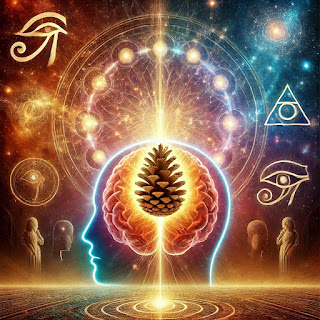The Pineal Gland: Mystical Symbol and Scientific Wonder
786
بِسْمِ اللَّهِ الرَّحْمَٰنِ الرَّحِيمِ,The pineal gland, a pea-shaped endocrine organ nestled deep within the brain, has captivated human imagination and inquiry for millennia. Revered across cultures and studied by modern science, this small yet potent gland continues to intrigue both spiritual seekers and scientists alike.
Historical and Symbolic Significance
Throughout history, the pineal gland has been associated with spiritual awakening and enlightenment, often referred to as the “Third Eye.” Its pine cone-like shape has made it a powerful symbol in diverse cultures and traditions:
Ancient Egypt: Egyptian mythology links the pine cone to the Eye of Horus, a symbol of protection, health, and restoration. This connection aligns the pineal gland with spiritual insight and higher states of consciousness.
The Vatican: The Vatican’s “Court of the Pine Cone” features a massive pine cone sculpture, suggesting the Church’s acknowledgment of the gland’s symbolic and spiritual significance.
Hinduism: In Hindu traditions, the pineal gland is connected to the concept of the “Ajna Chakra,” or Third Eye Chakra, representing intuition, perception, and transcendence.
Buddhism and Esotericism: Depictions of meditative states often include an illuminated Third Eye, symbolizing enlightenment and an elevated connection to the universe.
These associations suggest that ancient civilizations viewed the pineal gland as more than a physical organ; it was considered a bridge between the physical world and the metaphysical realms.
Philosophical Perspectives
The French philosopher René Descartes famously described the pineal gland as the "seat of the soul." He theorized that it served as the primary point of connection between the immaterial mind and the physical body. While his view has since been contested, it underscored the gland’s enigmatic nature and its perceived importance in human consciousness.
Scientific Understanding
Modern science has uncovered fascinating insights into the pineal gland’s biological functions:
Regulation of Circadian Rhythms: The pineal gland produces melatonin, a hormone that governs sleep-wake cycles. This role is critical for maintaining the body’s internal clock, influencing everything from mood to metabolism.
Reproductive Health: Studies in animals suggest the gland’s melatonin production impacts the hypothalamus and pituitary gland, which regulate sex hormones. Its influence on puberty and seasonal breeding cycles highlights its broader endocrine functions.
Bone Health: Emerging research suggests melatonin might play a role in regulating bone mass and preventing osteoporosis.
Neuroprotective Potential: Melatonin is a potent antioxidant, protecting the brain from oxidative stress and potentially reducing the risk of neurodegenerative diseases.
Mysticism Meets Modernity
What sets the pineal gland apart from other endocrine organs is its unique combination of spiritual and biological significance. Even in modern times, many believe it plays a role in:
Consciousness and Perception: Some propose that the gland is linked to altered states of awareness and intuition, potentially explaining its ancient association with mystical practices.
DMT Production: The pineal gland has been hypothesized to secrete dimethyltryptamine (DMT), a compound associated with vivid dreams and spiritual experiences. While the evidence is still under investigation, this theory adds another layer to its mystique.
Symbolism Across Civilizations
The recurring pine cone motif in art and architecture—from the staff of the Egyptian god Osiris to sculptures in ancient Mesopotamia and Greco-Roman temples—points to a shared reverence for this gland. It’s a testament to humanity’s enduring quest to understand the connection between body, mind, and spirit.
Conclusion
The pineal gland’s dual identity—as a biological regulator and a spiritual beacon—bridges ancient wisdom and modern science. Whether as the "seat of the soul," the “Third Eye,” or the master regulator of circadian rhythms, it serves as a reminder of the profound interconnectedness of human existence. This small yet mighty organ continues to inspire awe, beckoning us to explore the mysteries it holds.
Further Reading and Resources
Books
"The Seat of the Soul" by Gary Zukav
Explores the intersection of science, spirituality, and human consciousness, aligning well with the pineal gland's symbolic and mystical attributes."DMT: The Spirit Molecule" by Rick Strassman
A scientific investigation into DMT, a compound hypothesized to be associated with the pineal gland, offering insights into its potential links to altered states of consciousness."The Third Eye" by T. Lobsang Rampa
A controversial but intriguing perspective on spiritual awakening and the mystical aspects of the Third Eye, tying back to the pineal gland."Melatonin: Nature's Sleeping Pill" by Ray Sahelian
Focuses on the biological functions of melatonin, highlighting the pineal gland’s role in regulating sleep and circadian rhythms.
Articles and Papers
"Melatonin and Its Role in Human Health and Disease" (Journal of Pineal Research)
A detailed scientific review of melatonin's benefits and the pineal gland's role in overall health."The Role of the Pineal Gland in Endocrine Function" (Endocrine Reviews)
Examines the gland's influence on reproductive health and other hormonal processes."Spirituality and the Pineal Gland" (Frontiers in Human Neuroscience)
Investigates modern interpretations of the pineal gland’s connection to spirituality and altered states of perception.
Web Resources
The Smithsonian's Exploration of Ancient Egyptian Symbolism
smithsonianmag.com
Insights into the cultural significance of symbols like the Eye of Horus and their connections to anatomical features such as the pineal gland.Vatican’s Court of the Pine Cone - Symbolism Explained
vaticanstate.va
Details the historical and spiritual relevance of the pine cone sculpture."Ajna Chakra and the Third Eye in Hinduism" (Hinduism Today)
A comprehensive look at the spiritual practices associated with the Third Eye and their parallels to the pineal gland.
Documentaries and Videos
"The Spirit Molecule" (Documentary based on Rick Strassman's book)
Explores DMT's role in human consciousness and its potential connection to the pineal gland."Secrets of the Third Eye" (BBC Documentary)
Examines ancient cultures' reverence for the pineal gland and its symbolic importance.YouTube Series: "The Pineal Gland - Beyond Biology"
A mix of scientific and esoteric insights into the gland’s dual roles.




Comments
Post a Comment